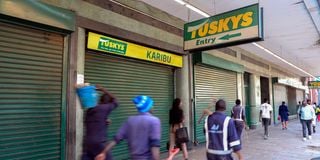Breaking News: At least 10 feared to have drowned in Makueni river
Court ends Tuskys 30-year journey with a liquidation order

A closed Tuskys outlet. High Court has ordered the liquidation of the Tuskys Supermarket chain. The chain's Sh6 billion asset base is just 30 percent of its debts meaning creditors will have to take a hit on their dues.
The High Court has ordered the liquidation of the Tuskys Supermarket chain, ending a 30-year-long journey for what was once one of East Africa’s biggest family-owned businesses.
Justice David Majanja on Wednesday ruled that there is no hope for rescuing Tuskys, which owes creditors close to Sh20 billion against an asset base of approximately Sh6 billion.
The judge held that the liquidation petition filed by Hotpoint Appliances and supported by dozens of creditors has been in court for three years and that nothing has been done to revive Tuskys in that time.
Justice Majanja added that Tuskys has not disputed its Sh19.7 billion debts, further advising his decision to end the company’s misery by appointing a liquidator to salvage something for creditors.
Kolluri Venkata Subbaraya Kamsastry has been appointed liquidator. He will be expected to audit the shell that is left, sell assets and use the proceeds to settle debts.
The Sh6 billion asset base is just 30 percent of Tuskys’ debts. This means creditors will have to take a hit on their dues, with a possibility of some going home empty-handed.
Joram Kago founded Tuskys in Nakuru in the late 1980s, before growing it into one of the biggest Kenyan companies.
Mr Kago, who previously worked at Nakumatt, died in 2002. Things initially seemed rosy with his children managing the retail chain.
But in 2011 control battles started plaguing the retailer as siblings fought each other.
On one side of the fence was Yusuf Mugweru, who accused his siblings – Stephen Mukuha, Samuel Gatei, John Kago, and George Gashwe – of mismanagement, embezzlement, and secrecy in handling books of accounts.
While the company seemed to only get bigger every year, things took a sharp turn in 2020 when suppliers started piling pressure on Tuskys over unpaid debts.
Tuskys blamed the non-payment on the Covid-19 pandemic.
But when Hotpoint filed an insolvency petition in August 2020 the magnitude of Tuskys’ debts started to unfold.
Hotpoint revealed that it was owed Sh248 million, and some of the debts stretched back to 2016. Several other creditors that supported the liquidation petition also presented historical claims whose non-payment was difficult to blame on the Covid-19 pandemic’s effects.
A few days after Hotpoint filed the insolvency petition, Tuskys claimed to have secured a foreign investor who would give the lender Sh2.1 billion to assist in restructuring operations, with more funds to follow.
But Tuskys declined to reveal the mystery investor’s name. At the time, supplier debts that required urgent payment had hit Sh6.2 billion, hence the initial investment could not cover it.
Later that year, sources within the retailer told the Nation that Tuskys received Sh500 million from the mystery investor, but that most of the funds were swallowed up by a bank overdraft.
Creditors refused to back out of the insolvency push unless specific details on the mystery investor were given.
The mystery investor had issued several conditions before pumping any more money into Tuskys, including convincing creditors to restructure their debt and await the retailer’s revival.
On Wednesday, Justice Majanja held that there is no hope of rescuing Tuskys and that the best option for the company is liquidation.





